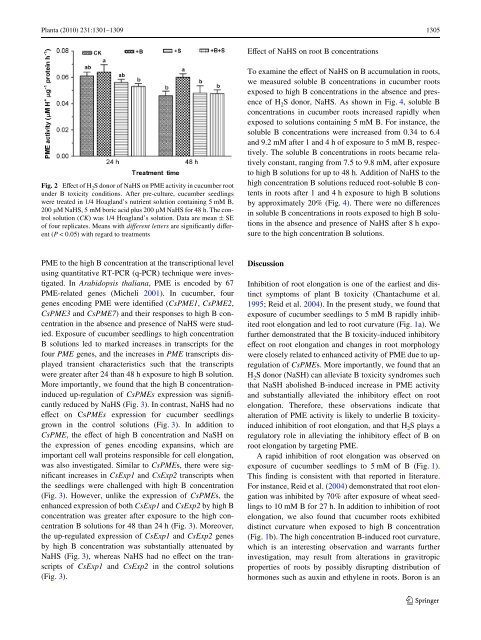(Cucumis sativus L.) seedlings
(Cucumis sativus L.) seedlings
(Cucumis sativus L.) seedlings
You also want an ePaper? Increase the reach of your titles
YUMPU automatically turns print PDFs into web optimized ePapers that Google loves.
Planta (2010) 231:1301–1309 1305EVect of NaHS on root B concentrationsFig. 2 EVect of H 2 S donor of NaHS on PME activity in cucumber rootunder B toxicity conditions. After pre-culture, cucumber <strong>seedlings</strong>were treated in 1/4 Hoagland’s nutrient solution containing 5 mM B,200 μM NaHS, 5 mM boric acid plus 200 μM NaHS for 48 h. The controlsolution (CK) was 1/4 Hoagland’s solution. Data are mean § SEof four replicates. Means with diVerent letters are signiWcantly diVerent(P < 0.05) with regard to treatmentsTo examine the eVect of NaHS on B accumulation in roots,we measured soluble B concentrations in cucumber rootsexposed to high B concentrations in the absence and presenceof H 2 S donor, NaHS. As shown in Fig. 4, soluble Bconcentrations in cucumber roots increased rapidly whenexposed to solutions containing 5 mM B. For instance, thesoluble B concentrations were increased from 0.34 to 6.4and 9.2 mM after 1 and 4 h of exposure to 5 mM B, respectively.The soluble B concentrations in roots became relativelyconstant, ranging from 7.5 to 9.8 mM, after exposureto high B solutions for up to 48 h. Addition of NaHS to thehigh concentration B solutions reduced root-soluble B contentsin roots after 1 and 4 h exposure to high B solutionsby approximately 20% (Fig. 4). There were no diVerencesin soluble B concentrations in roots exposed to high B solutionsin the absence and presence of NaHS after 8 h exposureto the high concentration B solutions.PME to the high B concentration at the transcriptional levelusing quantitative RT-PCR (q-PCR) technique were investigated.In Arabidopsis thaliana, PME is encoded by 67PME-related genes (Micheli 2001). In cucumber, fourgenes encoding PME were identiWed (CsPME1, CsPME2,CsPME3 and CsPME7) and their responses to high B concentrationin the absence and presence of NaHS were studied.Exposure of cucumber <strong>seedlings</strong> to high concentrationB solutions led to marked increases in transcripts for thefour PME genes, and the increases in PME transcripts displayedtransient characteristics such that the transcriptswere greater after 24 than 48 h exposure to high B solution.More importantly, we found that the high B concentrationinducedup-regulation of CsPMEs expression was signiWcantlyreduced by NaHS (Fig. 3). In contrast, NaHS had noeVect on CsPMEs expression for cucumber <strong>seedlings</strong>grown in the control solutions (Fig. 3). In addition toCsPME, the eVect of high B concentration and NaSH onthe expression of genes encoding expansins, which areimportant cell wall proteins responsible for cell elongation,was also investigated. Similar to CsPMEs, there were signiWcantincreases in CsExp1 and CsExp2 transcripts whenthe <strong>seedlings</strong> were challenged with high B concentration(Fig. 3). However, unlike the expression of CsPMEs, theenhanced expression of both CsExp1 and CsExp2 by high Bconcentration was greater after exposure to the high concentrationB solutions for 48 than 24 h (Fig. 3). Moreover,the up-regulated expression of CsExp1 and CsExp2 genesby high B concentration was substantially attenuated byNaHS (Fig. 3), whereas NaHS had no eVect on the transcriptsof CsExp1 and CsExp2 in the control solutions(Fig. 3).DiscussionInhibition of root elongation is one of the earliest and distinctsymptoms of plant B toxicity (Chantachume et al.1995; Reid et al. 2004). In the present study, we found thatexposure of cucumber <strong>seedlings</strong> to 5 mM B rapidly inhibitedroot elongation and led to root curvature (Fig. 1a). Wefurther demonstrated that the B toxicity-induced inhibitoryeVect on root elongation and changes in root morphologywere closely related to enhanced activity of PME due to upregulationof CsPMEs. More importantly, we found that anH 2 S donor (NaSH) can alleviate B toxicity syndromes suchthat NaSH abolished B-induced increase in PME activityand substantially alleviated the inhibitory eVect on rootelongation. Therefore, these observations indicate thatalteration of PME activity is likely to underlie B toxicityinducedinhibition of root elongation, and that H 2 S plays aregulatory role in alleviating the inhibitory eVect of B onroot elongation by targeting PME.A rapid inhibition of root elongation was observed onexposure of cucumber <strong>seedlings</strong> to 5 mM of B (Fig. 1).This Wnding is consistent with that reported in literature.For instance, Reid et al. (2004) demonstrated that root elongationwas inhibited by 70% after exposure of wheat <strong>seedlings</strong>to 10 mM B for 27 h. In addition to inhibition of rootelongation, we also found that cucumber roots exhibiteddistinct curvature when exposed to high B concentration(Fig. 1b). The high concentration B-induced root curvature,which is an interesting observation and warrants furtherinvestigation, may result from alterations in gravitropicproperties of roots by possibly disrupting distribution ofhormones such as auxin and ethylene in roots. Boron is an123


